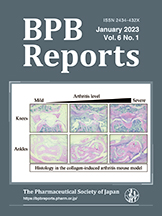Volume 6, Issue 3
Displaying 1-8 of 8 articles from this issue
- |<
- <
- 1
- >
- >|
Regular Article
-
2023 Volume 6 Issue 3 Pages 76-80
Published: 2023
Released on J-STAGE: May 12, 2023
Download PDF (1700K) Full view HTML
Regular Article
-
2023 Volume 6 Issue 3 Pages 81-86
Published: 2023
Released on J-STAGE: May 12, 2023
Download PDF (1415K) Full view HTML
Regular Article
-
2023 Volume 6 Issue 3 Pages 87-97
Published: 2023
Released on J-STAGE: May 26, 2023
Download PDF (4701K) Full view HTML
Report (Case Report)
-
2023 Volume 6 Issue 3 Pages 98-102
Published: 2023
Released on J-STAGE: May 26, 2023
Download PDF (890K) Full view HTML
Report
-
2023 Volume 6 Issue 3 Pages 103-107
Published: 2023
Released on J-STAGE: June 14, 2023
Download PDF (1474K) Full view HTML
Regular Article
-
2023 Volume 6 Issue 3 Pages 108-114
Published: 2023
Released on J-STAGE: June 14, 2023
Download PDF (2258K) Full view HTML
Regular Article
-
2023 Volume 6 Issue 3 Pages 115-121
Published: 2023
Released on J-STAGE: June 21, 2023
Download PDF (1932K) Full view HTML
Regular Article
-
2023 Volume 6 Issue 3 Pages 122-125
Published: 2023
Released on J-STAGE: July 04, 2023
Download PDF (916K) Full view HTML
- |<
- <
- 1
- >
- >|
